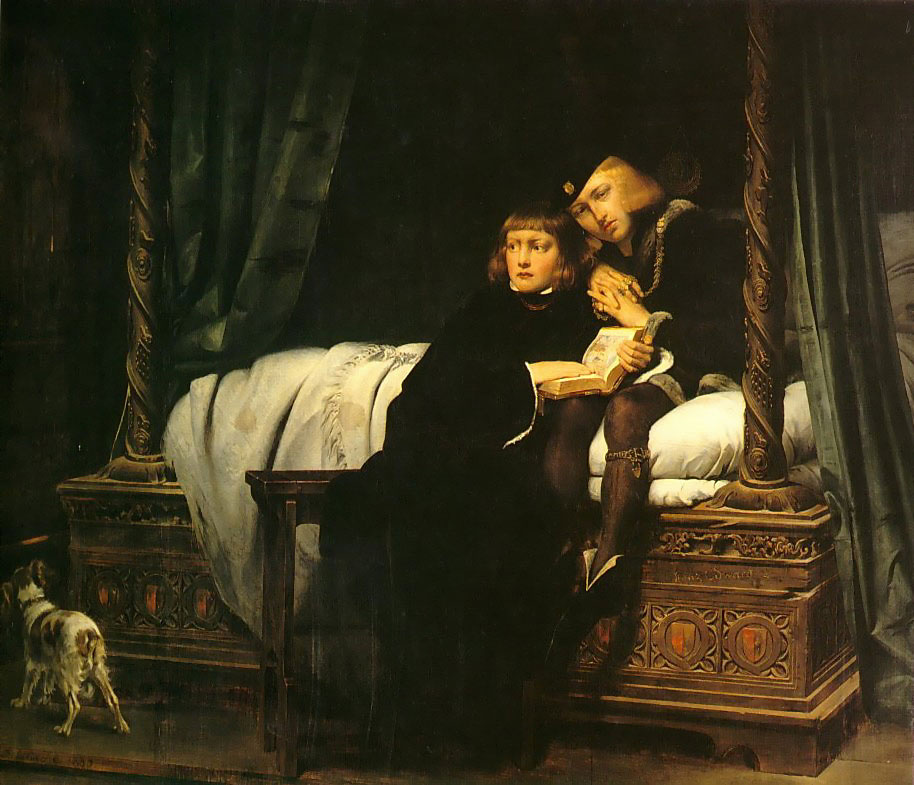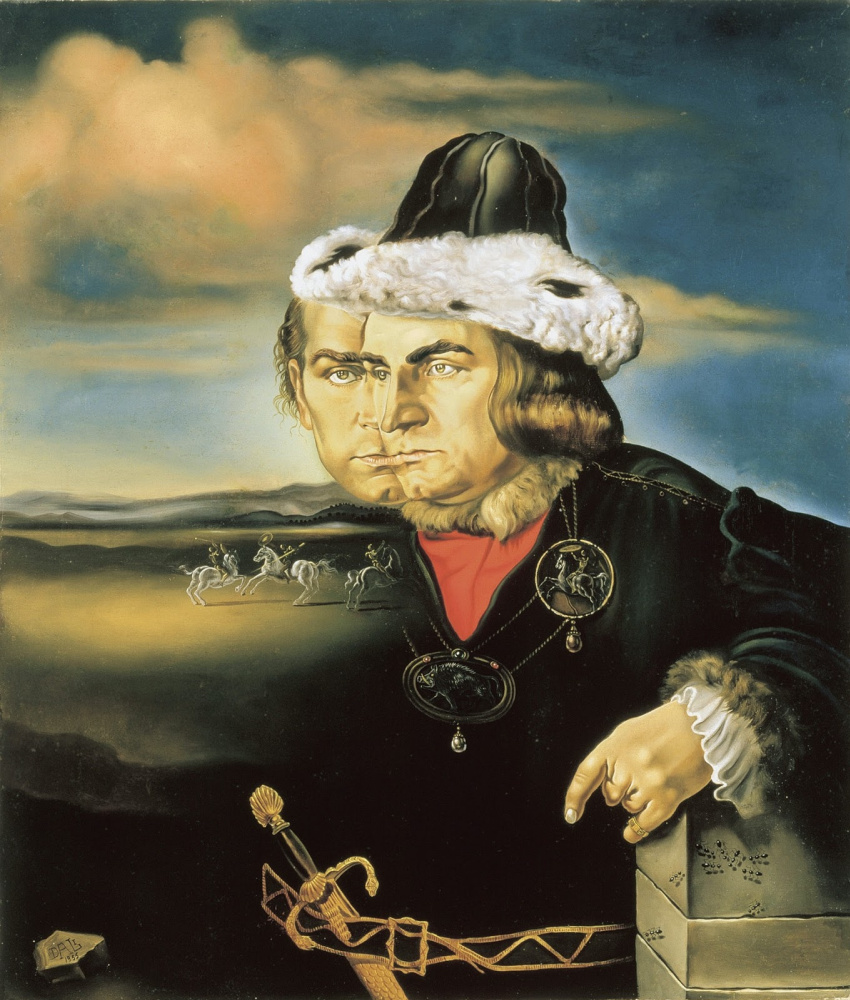On the completion of the main series of the decade, Arthive recalls who the real Tyrion, Daenerys and Ramsey were, and how they were painted by their contemporaries and descendants

Eddard Stark – Richard Plantagenet
Richard Plantegenet was the son of the 1st Duke of York, executed for treason, so he was actually an orphan in disgrace. However, in 1426 (Richard was only 15), Henry VI returned him the title, and his career went uphill. At the age of 24, he commanded the British troops in France, later he became the governor of Ireland (i.e., the Guardian of the North), and when the King was ill, he served as regent of England (that is, his right hand).
Left: Sean Bean as Eddard Stark. Right: Richard York (illustration from Talbot Shrewsbury, 1444)
Unlike Eddard Stark, Richard of York claimed the Iron Throne. In fact, his claims laid the foundation for the war of the Red and White Roses. Another difference is that Richard was not executed — he died in the Battle of Wakefield. However, his head was cut off from the dead body and put on public display.

Alfred Walter Bayes. The Duke of York Slain at Wakefield. 1866
Lancaster vs York and Lannister vs Stark — the hint is clear even at the phonetic level.
Richard’s heirs lived an active (albeit short) social and political life, just like the descendants of Eddard Stark. His son Edward IV became the first king of the York dynasty and almost the only man of the family who died from natural causes (he probably drank too much). At least nine Yorks were killed one way or another. For example, his son Duke Clarence was drowned in a barrel of wine, and Richard’s grandchildren Edward V and Richard Shrewsbury, the Duke of York, were most likely strangled with a pillow in the Tower.
Richard’s heirs lived an active (albeit short) social and political life, just like the descendants of Eddard Stark. His son Edward IV became the first king of the York dynasty and almost the only man of the family who died from natural causes (he probably drank too much). At least nine Yorks were killed one way or another. For example, his son Duke Clarence was drowned in a barrel of wine, and Richard’s grandchildren Edward V and Richard Shrewsbury, the Duke of York, were most likely strangled with a pillow in the Tower.
Cersei Lannister - Margaret of Anjou
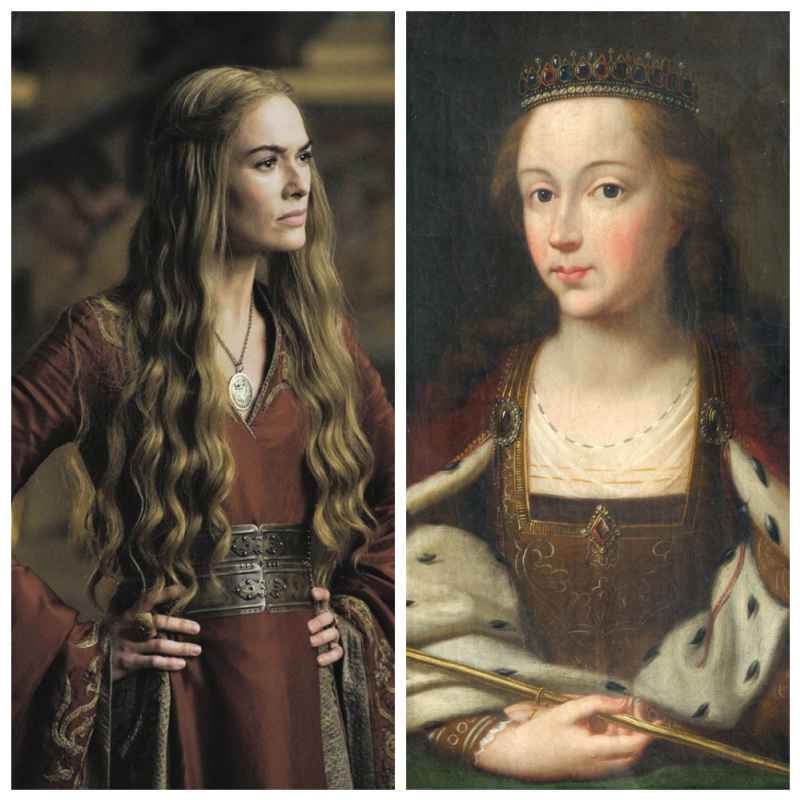
Left: Lina Headey as Cersei Lannister. Right: Portrait of Margaret of Anjou. Robert Davy 1775
Like Cersei, Margaret of Anjou skilfully made backroom deals and had a serious geopolitical influence. Her husband, King Henry VI, fell into insanity from time to time; in fact, the Queen Consort ruled England for him. Seeing that the Duke of York was becoming a too powerful figure, she succeeded in expelling him from the council, which provoked Richard so that he began to claim the throne; the War of Roses began, during which Margaret led the Lancaster faction.

Margaret of Anjou captured after the Battle of Tewkesbury. John Gilbert. 1875
With Cersei Lannister, she is related not only by an open confrontation with the right hand of her husband, but also by gossip about paternity. It was rumoured that the father of her son Edward (Edmund Blair Leighton portrayed his ascent to the throne in Vox Populi), was not Henry VI, but Edmund Beaufort, Duke of Somerset. However, he wasn’t Margaret’s brother, he was perhaps her brother in arms.

Edmund Blair Leighton. Vox Populi. 1904
Daenerys Targaryen – Henry VII

Left: Emilia Clark as Daenerys Targaryen. Right: portrait of Henry Tudor (unknown artist, 1505)
When Henry Tudor decided to lay claim to the English throne, he had no money, no strong supporters, no dragon eggs. His hereditary right was very doubtful — the marriage of his grandfather Owen Tudor with Catherine Valois was considered illegal (many people doubted even about the fact of marriage). This did not stop Henry: he systematically gathered troops, recruited mercenaries, and acquired allies. In the end, he defeated King Richard’s army and was proclaimed king right on the battlefield. This didn’t quite suit him — later he put in a lot of diplomatic and legal efforts so that everything looked as if he had won the throne not by right of conquest, but as the legitimate heir to the Lancaster.

Henry VII (centre) with his advisers — Sir Richard Ampson and Sir Edmund Dudley (unknown artist, late portrait)
Henry VII was a very sensible ruler; he also was too much bloodthirsty (especially compared to others): this is why the beginning of the Tudor era is called the beginning of the English Renaissance
. Humanistic impulses (as well as the dragon on the coat of arms) make Henry Tudor the most likely prototype of Daenerys. They have one more common detail — crazy ancestors. Daenerys was the Daughter of the Mad King Eiris, who burned people alive and was about to burn down the Royal Harbour. Henry is the great-grandson of Charles VI the Mad, whose biography also contains an episode with the code name "The Ball of Flames".
And the fact that Henry Tudor turned into a woman should neither surprise, nor outrage in our enlightened times.
And the fact that Henry Tudor turned into a woman should neither surprise, nor outrage in our enlightened times.

The Ball of Flames. Miniature from the Chronicle of Jean Froissart (1400s)
Tyrion Lannister - Richard III

Left: Peter Dinklage as Tyrion Lannister. Right: Portrait of Richard III (unknown author, 16th century)
According to George Martin himself, Richard III became the prototype of Tyrion Lannister. The king defeated in battle by Henry Tudor; unlike Daenerys and Tyrion, their prototypes were not allies.
Richard was the main anti-hero of English history for a long time. The black PR of Tudors took its toll: in literature and painting, Richard was usually portrayed as a cruel and unprincipled tyrant and a hunchbacked dwarf. In 2013, Richard’s remains were subjected to a variety of studies, from which (among other things) it turned out that the growth of the "dwarf" was 173 cm, and the "hump" was nothing more than scoliosis. The moral virtues of Richard III were also rehabilitated. Modern historians are not so sure that it was Richard who killed his nephews (those young men imprisoned in the Tower, painted by Paul Delaroche). Many people could do it — for example, the Duke of Buckingham or Henry Tudor. In a word, today Richard III and Tyrion Lannister have more in common than it seemed before: Richard also had a remarkable mind, was a brave man and suffered from the machinations of slanderers.
Richard was the main anti-hero of English history for a long time. The black PR of Tudors took its toll: in literature and painting, Richard was usually portrayed as a cruel and unprincipled tyrant and a hunchbacked dwarf. In 2013, Richard’s remains were subjected to a variety of studies, from which (among other things) it turned out that the growth of the "dwarf" was 173 cm, and the "hump" was nothing more than scoliosis. The moral virtues of Richard III were also rehabilitated. Modern historians are not so sure that it was Richard who killed his nephews (those young men imprisoned in the Tower, painted by Paul Delaroche). Many people could do it — for example, the Duke of Buckingham or Henry Tudor. In a word, today Richard III and Tyrion Lannister have more in common than it seemed before: Richard also had a remarkable mind, was a brave man and suffered from the machinations of slanderers.
Portrait of Lawrence Olivier as Richard III
1955, 73×63 cm
Joffrey Baratheon - Edward Lancaster - Don Carlos
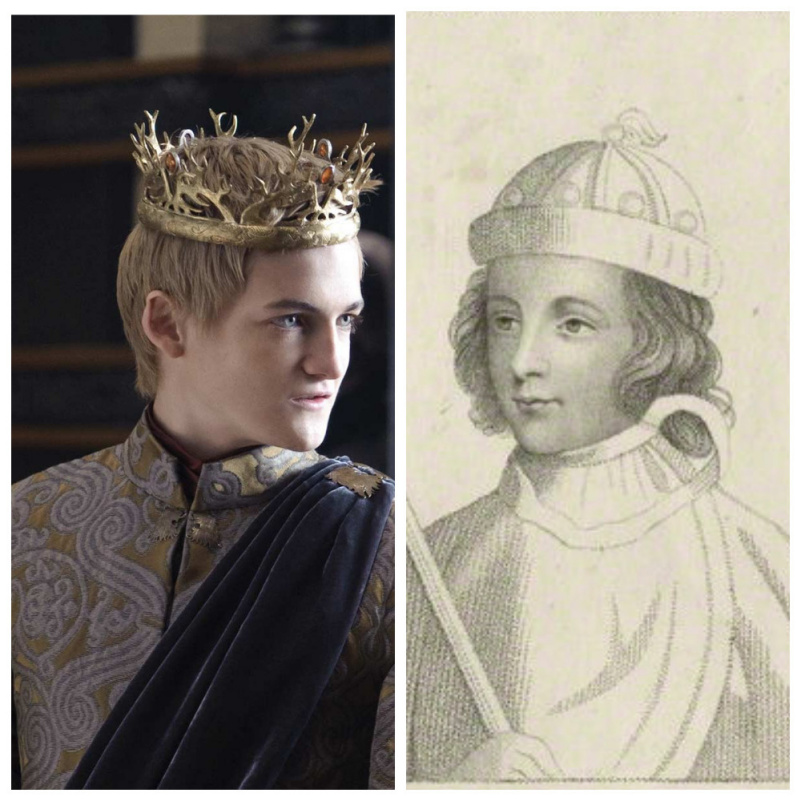
Left: Jack Gleeson as Joffrey Baratheon. Right: Edward of Westminster (Sylvester Harding, 1793)
Many fans of the Game of Thrones consider that the historical prototype of the monstrous Joffrey Baratheon is Edward of Westminster, the son of Margaret of Anjou. The dubious origin of the heir, as well as some of his characterological features, speaks in favour of this version. In infancy, Edward suffered a severe psychological trauma — the parliament appointed Richard Plantagenet (and not the one-year-old prince) as regent and reduced, in this regard, the number of boy’s servants to 39 people. Perhaps this contributed to the fact that Edward grew up a very cruel character: he loved to attend executions (and therefore he often passed death sentences).
He was killed during the Battle of Tewkesbury.
He was killed during the Battle of Tewkesbury.
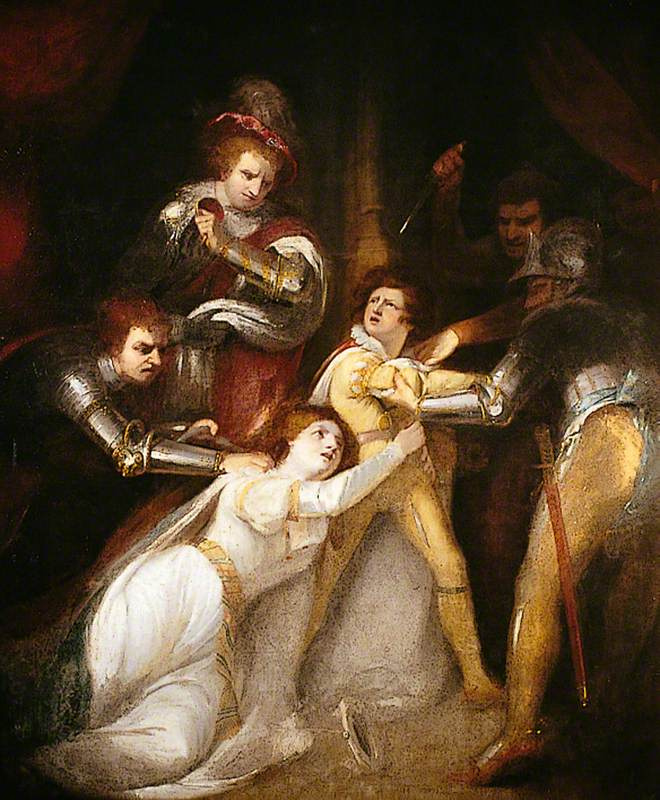
James Northcote. The Murder of Edward, Prince of Wales, at Tewkesbury. 1800s
George Martin used to draw inspiration from English history, he was especially interested in the period of the War of Red and White Roses. However, world history is teeming with small bloodthirsty bastards, so Martin could easily find the prototype of Joffrey outside of England.
For example, Don Carlos, Prince of Asturias, the son of the Philip II of Spain. This baby, according to the report of the Venetian ambassador to the Spanish court, was "born with teeth", and the first word he said was "no". As a teenager, he mutilated horses and roasted caught rabbits alive. As he became older, he set about girls. His favourite pastime was castrating his subjects: among the prince’s expenses, there were many bills in compensation for those who suffered from this prank (like the Lannisters, he always paid his debts). Then Carlos fell down the stairs, chasing another victim, bruised his head, suffered cranial trepanation and finally cracked up. His father had to keep him in custody until the end of his life (the prince died of a malaria attack, the symptoms of which are similar to those of Joffrey’s poisoning).
For example, Don Carlos, Prince of Asturias, the son of the Philip II of Spain. This baby, according to the report of the Venetian ambassador to the Spanish court, was "born with teeth", and the first word he said was "no". As a teenager, he mutilated horses and roasted caught rabbits alive. As he became older, he set about girls. His favourite pastime was castrating his subjects: among the prince’s expenses, there were many bills in compensation for those who suffered from this prank (like the Lannisters, he always paid his debts). Then Carlos fell down the stairs, chasing another victim, bruised his head, suffered cranial trepanation and finally cracked up. His father had to keep him in custody until the end of his life (the prince died of a malaria attack, the symptoms of which are similar to those of Joffrey’s poisoning).
Don Carlos, Prince of Asturias
1550-th
, 109×95 cm
Ramsey Bolton – William the Conqueror

Left: Ivan Reon as Ramsey Bolton. Right: William the Conqueror (unknown author)
The version that William II, the Duke of Normandy, (later known in history as William I the Conqueror, the King of England) was the prototype of Ramsey Bolton may seem like speculation. However, these characters definitely have something in common.
The character guys like so much appeared on the series as Ramsey Snow. And his alleged prototype was called Guillaume the Bastard before becoming William I. He was the only (albeit illegitimate) son of the ruler of Normandy, Robert II the Magnificent (knowledgeable people called him Robert the Devil). Guillaume’s maternal grandfather was a furrier — another obvious parallel: the Bolton family also knew a lot about leather crafts and never missed an opportunity to skin somebody alive.
After the death of Robert (who called William his legal heir), the young man constantly had to fight for his rights. Once he happened to besiege the castle of Alanson in the county of Maine — the townspeople refused to obey "some furrier". Taking the castle, William tore the skin from the scoffers alive. However, some researchers believe that such atrocities are a legend: William simply chopped offenders' hands and feet.
Later, after he had conquered England, William launched a campaign called the Harrying of the North — Yorkshire and other northern counties were ravaged by his troops. William died in a ridiculous accident. In 1087, the plump and clumsy 60-year-old king fell off his horse and severely damaged his stomach with his own saddle.
The character guys like so much appeared on the series as Ramsey Snow. And his alleged prototype was called Guillaume the Bastard before becoming William I. He was the only (albeit illegitimate) son of the ruler of Normandy, Robert II the Magnificent (knowledgeable people called him Robert the Devil). Guillaume’s maternal grandfather was a furrier — another obvious parallel: the Bolton family also knew a lot about leather crafts and never missed an opportunity to skin somebody alive.
After the death of Robert (who called William his legal heir), the young man constantly had to fight for his rights. Once he happened to besiege the castle of Alanson in the county of Maine — the townspeople refused to obey "some furrier". Taking the castle, William tore the skin from the scoffers alive. However, some researchers believe that such atrocities are a legend: William simply chopped offenders' hands and feet.
Later, after he had conquered England, William launched a campaign called the Harrying of the North — Yorkshire and other northern counties were ravaged by his troops. William died in a ridiculous accident. In 1087, the plump and clumsy 60-year-old king fell off his horse and severely damaged his stomach with his own saddle.
Petyr Baelish – Thomas Cromwell

Left: Aidan Gillen as Petyr Baelish. Right: Thomas Cromwell (Hans Holbein the Younger, 1538)
Thomas Cromwell, the son of the innkeeper and the grandson of the blacksmith, has come a long way: from the slums to the Privy Council of King Henry VIII, from the everyday "young thug" (as Cromwell himself described his young years) to the status of one of the most influential characters in English politics.
The meteorical career of Thomas Cromwell began after he deserted from the French army (where he served as a mercenary) and settled in Florence. Here he went into banking, had close financial relations with the Holy See. In England, he gained political weight by taking advantage of the ideas of the reformation. He held the position of Chancellor of the Treasury (that is, he was a "Coin Master"). He was later appointed Secretary of State and Chief Minister. Being a connoisseur and admirer of Machiavelli, he was no less virtuoso intriguer than Petyr Baelish.
The meteorical career of Thomas Cromwell began after he deserted from the French army (where he served as a mercenary) and settled in Florence. Here he went into banking, had close financial relations with the Holy See. In England, he gained political weight by taking advantage of the ideas of the reformation. He held the position of Chancellor of the Treasury (that is, he was a "Coin Master"). He was later appointed Secretary of State and Chief Minister. Being a connoisseur and admirer of Machiavelli, he was no less virtuoso intriguer than Petyr Baelish.
Portrait of Thomas Cromwell
1533, 78.4×64.5 cm
Bailish is known to get his nickname "Littlefinger" for his low height. There is no reliable evidence that Thomas Cromwell was short. However, he definitely became lower after he was arrested for treason and beheaded.
Tywin Lannister – Richard Neville, Earl of Warwick

Right: Charles Dance as Tywin Lannister. Right: Portrait of Richard Neville (unknown artist, 17th century)
Richard Neville began his career early. At the age of seven he married (it was an important political marriage, which allowed him to subsequently become Earl of Warwick). At 16 he received the knighthood, and at 21 he became the sole heir to several of the richest and most noble families.
Like Tywin Lannister, Richard Neville was the most influential political figure of his time: the results of military campaigns and complex palace intrigues depended on his financial support. Like Tywin Lannister, Neville did not try to sit on the iron throne, preferring to rule by proxy. Tywin was the right hand — at first of Targaryen, and then of Baratheon. During the War of Roses, Neville helped Richard Plantagenet defeat Henry VI at first, thus acting on the side of the Yorks. Then he played for the Lancaster, trying to topple Edward IV and seat Henry VI on the throne.
Shakespeare in his Henry VI trilogy called him "the king-maker and king-destroyer". And his surname "the king-maker" came into use as a political term.
Like Tywin Lannister, Richard Neville was the most influential political figure of his time: the results of military campaigns and complex palace intrigues depended on his financial support. Like Tywin Lannister, Neville did not try to sit on the iron throne, preferring to rule by proxy. Tywin was the right hand — at first of Targaryen, and then of Baratheon. During the War of Roses, Neville helped Richard Plantagenet defeat Henry VI at first, thus acting on the side of the Yorks. Then he played for the Lancaster, trying to topple Edward IV and seat Henry VI on the throne.
Shakespeare in his Henry VI trilogy called him "the king-maker and king-destroyer". And his surname "the king-maker" came into use as a political term.
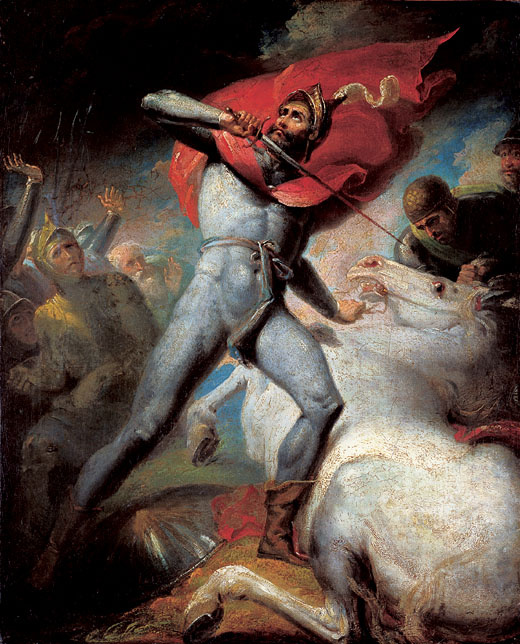
The Earl of Warwick’s Vow Previous to the Battle of Towton. Henry Tresham. 1797






